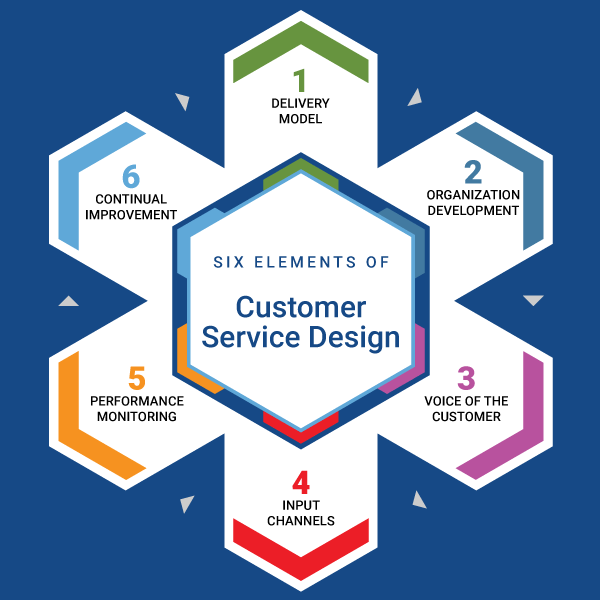
Large companies often want to develop customer service as a differentiating factor. However, they face challenges when they attempt to design the right solution.
- Limited resources, including the inability to invest in front-line personnel–many companies opt for offshore solutions
- Lack of systems to manage the flow of information between customers, contact centers, and factories/suppliers
By combining “ease of doing business” initiatives with the proper system support, companies can improve customer experience and gain operational efficiencies.
Customer Service Design: Think from a Customer
In addition to considering process and technology, organizations must put themselves in their customer’s shoes to gain an understanding of their wants and needs before they can provide outstanding customer service.
Below are six elements to consider across people, processes, and technology when creating your customer service strategy.
1—Customer Service Delivery Model
Companies should balance transaction-based, expertise-based, and strategy-based elements within your overall service delivery model.
People: Enable collaboration mechanisms within and across teams and departments, and choose where you place the tradeoff between high-touch service and efficiency.
Process: Create a culture of proactive customer communication that allows your customer service team to manage news with their customers.
Technology: Invest in technology updates to maintain functionality.
2—Organization Development
Customers remember positive interactions where team members solved their real problems and didn’t just explain the process or the system.
People: Provide customer service training based on who your buyers are, what matters to them, and how to solve the problems they are experiencing.
Process: Through hiring, selection, and onboarding, companies should bring in the right talent and provide growth plans for existing personnel.
Technology: Provide training sessions focused on desired behaviors, product knowledge, and supporting technology.
3—Voice of the Customer
Gathering feedback from customers is worthless if you don’t act upon it.
People: Don’t discount the feedback from your front-line personnel. They interact with the customer.
Process: Analyze the results of structured interviews, focus groups, electronic surveys, and external sources to triangulate opportunities.
Technology: Ask what technology solutions are required or desired and how those recommendations stack against your competitors.
4—Input Channels
Customers navigate to and through your organization differently, but they all carry the same expectations.
People: Ensure your service organization supports product, geographic (language, time zone), and technology alignment.
Process: Capture, document, triage, and strive for first-call resolution, but route questions to the proper person for accurate answers.
Technology: Deploy the input channels needed by your customers, whether public web, authenticated portals, email, phone, or social media.
5—Performance Monitoring
You must have clear, objective metrics and understand the context in which those measures exist.
People: Adjust performance expectations based on the customers served by the individual.
Process: Give regular feedback about performance to team members.
Technology: Use technology to monitor performance and provide qualitative and quantitative quality measures.
6—Continual Improvement (CI)
Incremental improvements add up significantly over time.
People: Consider everyone at the outset of every CI project: No one person or department should monopolize ideation.
Process: Explore causes of exceptions (rushes, changes, holds) and seek to reduce occurrences. Ensure cross-functional alignment of the tradeoffs when making changes.
Technology: Provide visibility into activities across the end-to-end process to identify trends and issues.
Clear iQ’s Approach to Customer Service
Clear iQ engages with all stakeholders, from customer service employees and managers to executives, to develop practical solutions for improving customer service. To do this, we:
- Work with your team to understand what works well and what needs improvement
- Balance the need for continual incremental improvements with breakthrough innovation of transformational projects
- Identify and measure performance attributes even when you don’t think you have the data
- Provide roadmaps for technology and process improvement and then work with you along the journey
- Conduct voice of the customer activities as an independent, neutral party